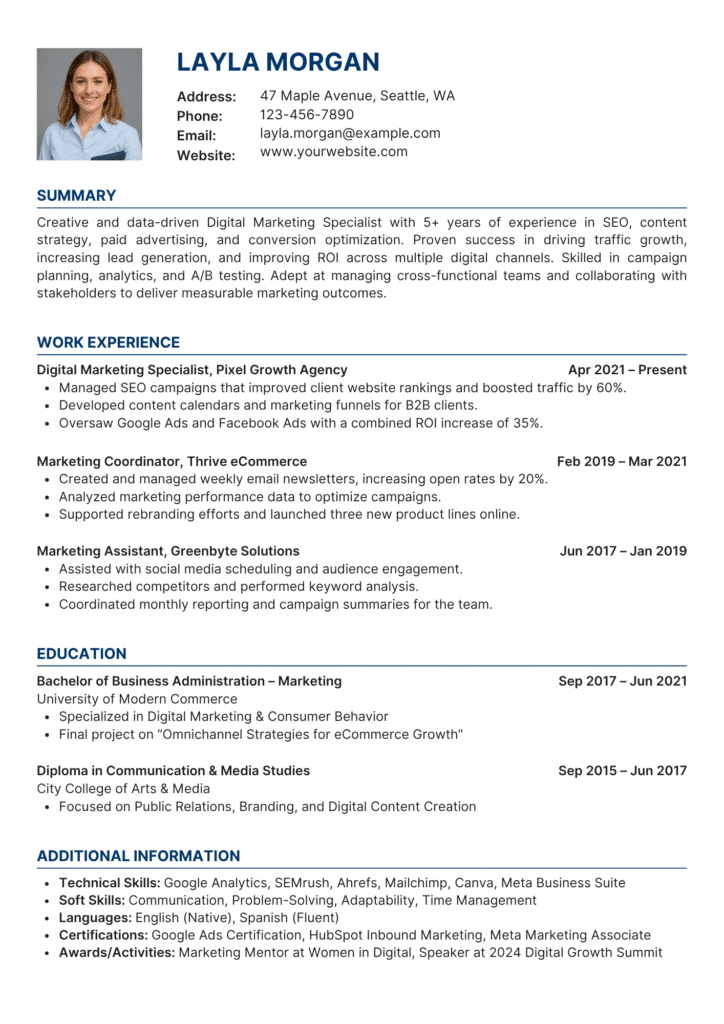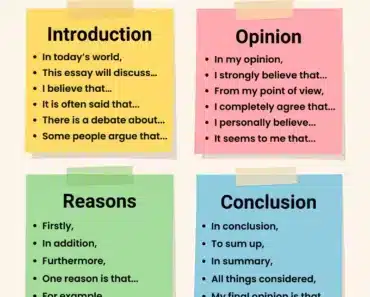
Writing a professional CV in English is essential for job applications in international companies and English-speaking countries. A CV (Curriculum Vitae) is a document that highlights your education, work experience, skills, and qualifications.
In this guide, you’ll learn how to write a CV in English step by step, including what a CV is, the difference between a CV and a resume, what sections to include, how to format and design your CV, and the most common mistakes to avoid.
What Is a CV?
A CV (Curriculum Vitae) is a formal document that people use to apply for jobs. It gives a clear summary of your education, work experience, skills, and qualifications. The purpose of a CV is to show employers why you are a good fit for a job.
The term Curriculum Vitae is Latin and means “course of life.” In modern English, it simply refers to a document that shows your career path and achievements.
When you apply for a job, the employer doesn’t know you — your CV is your first impression. A well-written CV helps you stand out, makes you look professional, and increases your chances of getting a job interview.
Difference Between a CV and a Resume
The terms CV and resume are often used when applying for jobs, and they both describe a document that shows your work experience, education, and skills. However, there are some small differences between them, depending on the country.
A CV (Curriculum Vitae) is more commonly used in the UK, Europe, Asia, and many other parts of the world. It is usually 1–2 pages long and gives a full overview of your career, including education, job history, and other qualifications. For academic or research positions, a CV can be much longer.
A resume is more common in the United States and Canada. It is usually shorter, often just one page, and focuses only on the most relevant information for the specific job you’re applying for.
What Should a CV Include?
A good CV presents clear, organized information to help employers quickly understand who you are and what you can do. While every CV may look slightly different, most professional CVs include these main sections:
1. Contact Information
Place this at the top of your CV and include only professional, relevant details. Avoid personal information like birth date, nationality, or a photo unless specifically required.
- Your full name
- Phone number (with country code if applying internationally)
- Professional email address
- City and country (full address is not needed)
- LinkedIn or portfolio link (optional)
2. Personal Profile
Write a short paragraph (2–4 sentences) summarizing your experience, skills, and goals. It should give employers a quick sense of who you are.
Example:
Motivated sales assistant with over 4 years of experience in customer service and product marketing. Strong communication skills and a proven record of meeting targets. Looking to contribute to a dynamic retail team.
3. Work Experience
List your past jobs, starting with the most recent one. For each job, include:
- Job title
- Company name
- Location (city, country)
- Dates of employment (month/year – month/year)
- 2–4 bullet points describing your main tasks and achievements
4. Education
List your most recent or highest education first. Include:
- Name of the degree or qualification
- Name of the school or university
- Location (city, country)
- Dates attended (month/year – month/year)
- Optional: awards, GPA, or major subjects
5. Skills
List a mix of technical and soft skills relevant to the job. Group them clearly to make scanning easier.
- Soft Skills: teamwork, time management, adaptability, problem-solving
- Technical Skills: Excel, WordPress, Photoshop, HTML/CSS, Google Analytics
6. Additional Sections
Depending on your background or the job you’re applying for, you may include:
References: Simply write “Available upon request” unless asked otherwise.
Languages: List each language with your level (e.g., English – Fluent, Spanish – Intermediate).
Certificates & Courses: Add any short courses, certifications, or workshops you’ve completed.
How to Write a CV in English
Writing a CV in English requires more than just listing information; it also depends on how clearly and professionally you present it. Even if you’re not fluent, you can create a strong CV by following a few practical tips on structure, vocabulary, and tone.
1. Use simple and formal language
Keep your sentences short and clear. Avoid slang or informal phrases like “I’m super good at talking to people.” Use professional language that focuses on skills and actions. Stay formal but natural, and avoid complicated words. Focus on clarity and accuracy.
2. Start bullet points with action verbs
In the work experience section, begin each bullet with a strong verb to sound confident and active. This helps employers quickly understand your role and contributions.
Examples of action verbs:
- Managed – Managed daily team tasks and schedules.
- Designed – Designed marketing materials for product launches.
- Organized – Organized weekly team meetings and prepared agendas.
- Led – Led a cross-functional project team to meet deadlines.
- Created – Created a new inventory system that reduced errors.
- Assisted – Assisted customers with product inquiries and purchases.
- Developed – Developed training manuals for new employees.
- Improved – Improved customer response time by 25%.
3. Avoid personal pronouns (I, me, my)
You don’t need to use words like “I” or “my” in a CV. Employers know you are talking about yourself. Instead of saying “I handled customer calls,” just write “Handled customer calls.” This is the correct and professional style for CV writing in English.
4. Be specific, not general
Avoid vague descriptions like “hardworking” or “team player” unless you support them with real examples. It’s better to show what you did than use empty words. Instead of “Good at time management,” say “Completed tasks on deadline while managing multiple projects.”
5. Use numbers where possible
Numbers make your experience clearer and more measurable. If you increased sales, managed a budget, or handled many clients, include that information.
Example: Increased monthly sales by 20% through product recommendations.
6. Keep verb tenses consistent
Use the present tense for your current job and past tense for previous jobs.
- Current job: Manage daily reports, lead team meetings.
- Previous job: Managed client accounts, supported sales team.
7. Check spelling and grammar
Proofread carefully before sending your CV. Use a grammar tool like Grammarly to check punctuation, verb forms, capitalization, and formatting. Even small mistakes can leave a bad impression on employers.
How to Format and Design Your CV
Formatting and design are just as important as the content of your CV. Even with strong experience, a poorly designed CV can look unprofessional and be hard to read. A good layout makes your CV clean, organized, and easy to follow.
1. Keep the Layout Simple and Clear
Use a single-column layout and avoid decorative boxes or complex designs unless applying for a creative role. A clean, simple format looks more professional and is easier to read. If unsure, try free CV templates on Canva for simple, modern layouts. Use clear section headings and space them out:
- Personal Profile
- Work Experience
- Education
- Skills
- Languages
- Certificates
2. Use Professional Fonts
Choose a clean, easy-to-read font and avoid decorative or unusual styles. Use size 11–12 for body text and 14–16 for headings. Good font choices include:
- Arial
- Calibri
- Helvetica
- Times New Roman
3. Keep Your CV One to Two Pages
Limit your CV to two pages at most. One page is enough if you’re early in your career. Include only relevant and recent information. Avoid repeating the same tasks under multiple jobs.
4. Use Bold Text for Important Information
Use bold text to highlight key details and make your CV easier to scan. This helps employers quickly find the most important information. Keep it consistent and avoid overusing bold or underlining. Use bold text for:
- Section headings
- Job titles
- Company names
5. Align All Text to the Left
Left-aligned text is the easiest to read. Do not center everything on the page. Keep your text and bullet points lined up neatly along the left side for a professional look.
6. Use Bullet Points, Not Paragraphs
Bullet points make your CV easier to read and scan. Use them to list job responsibilities, skills, or achievements instead of long paragraphs. Keep each bullet point:
- One to two lines max
- Focused on one task or result
- Starting with a strong verb
7. Use Consistent Formatting
Keep the same formatting throughout your CV to make it look polished and professional. This includes:
- Font type and size
- Spacing between sections
- Date format (e.g., Jan 2022 – Dec 2023)
- Bullet point style
8. Save and Send as a PDF
Always save your CV as a PDF before sending it. This keeps your layout exactly as you designed it, no matter what device or software the employer uses. Do not send Word or editable files unless the employer asks for it. Name your file professionally, like:
- firstname_lastname_CV.pdf
- david_smith_resume.pdf
Common Mistakes to Avoid in a CV
Many CVs are rejected because of small but serious mistakes. Before sending your CV, make sure you avoid the following:
1. Spelling and Grammar Errors
Always check your English. Use a grammar tool or spell checker, and review your CV carefully. Even small mistakes can make you look careless or unprofessional.
2. Too Much Personal Information
Do not include your age, nationality, marital status, religion, or a photo (unless required). These details are usually unnecessary and unprofessional.
3. Unprofessional Email Address
Your email should be simple and professional. Avoid nicknames or old email handles. Use something like firstname.lastname@gmail.com.
4. Long Paragraphs Instead of Bullet Points
Don’t write full paragraphs when describing your work experience. Use bullet points to keep your CV clear and easy to scan.
5. Using the Same CV for Every Job
Customize your CV for each job. Focus on the experience and skills that are most relevant to the position you’re applying for.
6. Messy or Inconsistent Formatting
Use consistent fonts, spacing, and layout throughout your CV. A clean and organized format creates a better first impression.
7. Using “I” or “my”
CVs should not include personal pronouns. Instead of “I managed a team,” just write “Managed a team.”
Conclusion
Writing a CV in English is easier when you follow a clear structure and use professional language. In this guide, you learned what a CV is, how it differs from a resume, what to include, how to write each section, format it correctly, and avoid common mistakes.
Before applying, always review your CV carefully. A clear, well-formatted, and error-free CV in English can help you stand out and improve your chances of success in any job application.



